Maximizing Storage with Stylish Closet Drawers and Shelves
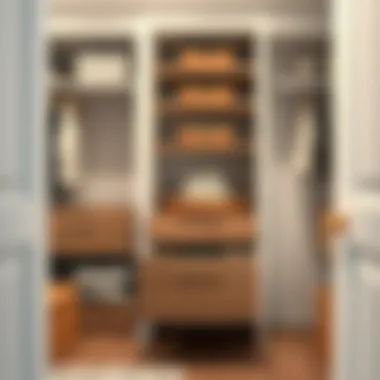
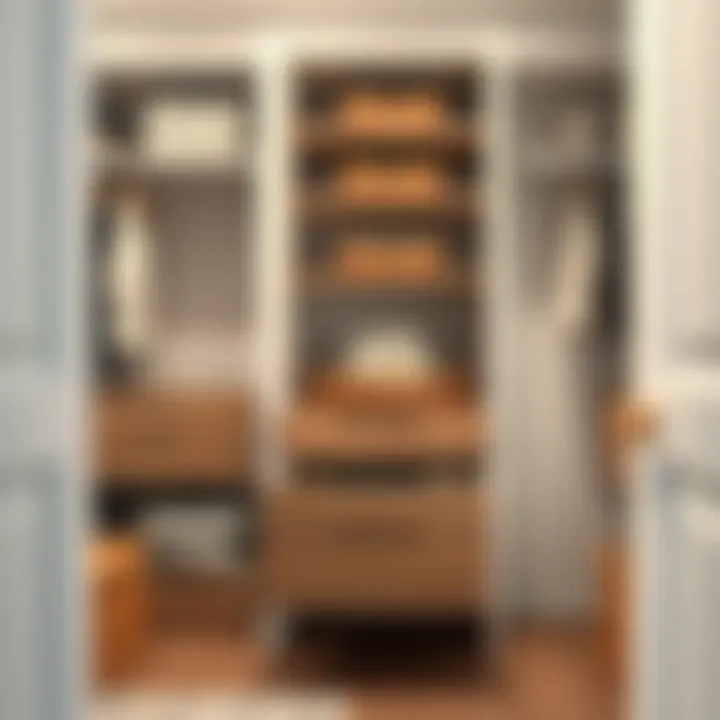
Intro
In the realm of interior design, achieving a balance between aesthetics and functionality is often the ultimate goal. One area that frequently gets overlooked is storage, particularly closet drawers and shelf units. This discussion will examine how these elements not only enhance organization but also contribute to the overall design of a space. As homes evolve to accommodate contemporary living needs, understanding the significant role of these storage solutions becomes essential.
Closet drawers and shelf units can transform a cluttered area into a functional oasis. Rather than being mere afterthoughts, these fixtures can serve as integral components of a well-crafted design plan. With numerous materials and designs available, every homeowner can find options that align with their vision while fulfilling practical needs. Let's explore the insights and strategies that turn storage from an inconvenience into an art form.
Furniture Design Insights
Understanding Style Preferences
When it comes to selecting closet drawers and shelf units, style preference often dictates the choices made. The wide array of designs available today—from minimalist to traditional—allows homeowners to express their unique tastes. For instance, sleek, modern shelves made from reclaimed wood can reflect both a contemporary aesthetic and an environmentally conscious choice. Conversely, ornate antique drawers may evoke a sense of nostalgia and richness in a room that appreciates history.
Choosing the right style is about more than just looks. It involves considering the overall theme of your home. If you are looking to create cohesion throughout different rooms, think about how each piece complements other furniture and decor.
Here are a few popular style preferences:
- Modern: Clean lines, neutral palettes, and functionality.
- Rustic: Natural materials, vintage finishes, and warmth.
- Industrial: Metal accents, exposed hardware, and warehouse-inspired designs.
- Scandinavian: Simple forms, bright colors, and emphasis on efficiency.
Maximizing Space with Smart Layouts
Beyond style, the layout of closet drawers and shelf units directly influences the efficiency of space. In small rooms, ensuring that every inch is used wisely can change the entire atmosphere from cramped to cozy. A thoughtful arrangement can unlock hidden potential in a space.
Consider the following tips:
- Vertical space utilization: Make use of wall height by installing taller shelves or stacked drawers.
- Corner units: Employ corner shelves to maximize often wasted spaces.
- Modular systems: Opt for adjustable shelving that can be tailored to fit various items over time.
- Integrated solutions: Combine drawer units with hanging rods to create a cohesive storage area.
"Using vertical space effectively can elevate a room's design while enhancing its functionality."
In commercial spaces, smart layouts are equally critical. Retail environments can benefit from modular displays that create a seamless flow, allowing products to shine while also providing necessary storage. Designers must think strategically about sightlines and accessibility, incorporating drawer units that are easy to open and shelves that offer clear visibility of items.
Maintenance and Care Tips
Cleaning Techniques for Different Materials
Once you have selected the perfect storage solutions, it's essential to maintain them. Different materials require unique care strategies to keep them looking their best. Here’s a brief guide:
- Wood: Use a soft cloth and a wood-safe cleaner. Avoid excessive moisture.
- Metal: Clean with a damp cloth; avoid abrasive sponges to prevent scratches.
- Glass: Wipe with a glass cleaner or vinegar solution for a streak-free shine.
Preventative Measures Against Wear and Tear
Ultimately, prevention is better than cure. Here’s how to keep your storage units in tip-top shape:
- Keep heavy items on lower shelves to avoid tipping.
- Schedule regular checks for loose hardware or wear on drawer slides.
- Consider using coasters or felt pads to avoid scratches on surfaces.
For more information on organizational strategies and home design trends, consider visiting resources such as Wikipedia's Home Design page or Britannica for Storage Solutions.
By harmonizing elegance with utility, closet drawers and shelf units become more than mere furniture—they turn into essential design allies.
Prologue to Closet Drawers and Shelf Units
In the intricate arena of home design, closet drawers and shelf units emerge as unsung heroes, quietly shaping our daily lives through their practical functionality and smart storage solutions. Understanding their role in maximizing space is vital, particularly for homeowners and designers aiming for both style and utility. These fixtures not only help keep clutter at bay but also allow for a personalized touch that can enhance the aesthetic of any room.
Understanding Storage Solutions
Storage solutions are not merely about stashing away belongings; they are about fostering an organized environment which can lead to a more peaceful mindset. Closet drawers serve as compartments that allow for the efficient categorization of items, from clothing to accessories. A well-designed system can make retrieving a favorite shirt as quick as a snap of the fingers, eliminating the frustration of rummaging through clutter.
When you approach storage with a strategic mindset, you optimize every nook and cranny of your space. For example, deep drawers can accommodate bulkier items while shallow trays can hold smaller objects like socks or ties. Additionally, modular systems offer the flexibility to adjust to changing needs, ensuring that as life's circumstances shift, your storage solutions can evolve in tandem. Understanding these principles can significantly impact the functionality of your home.
History and Evolution of Closet Systems
The evolution of closet systems tells a compelling story of changing lifestyles and innovations in design. Historically, people relied on chests and armoires to hold their belongings, often limiting their ability to utilize space effectively. As design philosophies shifted—partly triggered by industrialization—closets transitioned from bulky furniture to integrated wall systems that optimize both storage and space.
In the late 20th century, designers began to recognize the value of built-in solutions, paving the way for modern closet systems. With advancements in materials and technology, today’s closet systems can be tailored to fit almost any space, reflecting individual identities through personalized configurations.
"The journey from simple storage to sophisticated solutions reveals much about our evolving relationship with our possessions and spaces."
Now, as we navigate the fast-paced world of contemporary living, the importance of closet drawers and shelf units has only grown. They act not just as organizers but as contributors to the overall functionality and vibe of a home, bridging the gap between chaos and order. Recognizing this importance makes it imperative for both designers and everyday homeowners to carefully consider how they plan storage in their environments, ensuring every element works harmoniously together.
Ultimately, the strategic use of closet drawers and shelf units offers multifaceted benefits. It allows one to maximize storage, enhance aesthetics, and maintain a sense of order, all while embracing the stories behind the objects that fill our homes.
Functional Benefits of Closet Drawers
Closet drawers play a pivotal role in the overall organization and usability of any storage area. They are more than just compartments; they are the unsung heroes of functional home design. The way they contribute to efficient organization, space maximization, and privacy cannot be overstated. Let’s break down these essential benefits that help elevate the design and functionality of interiors.
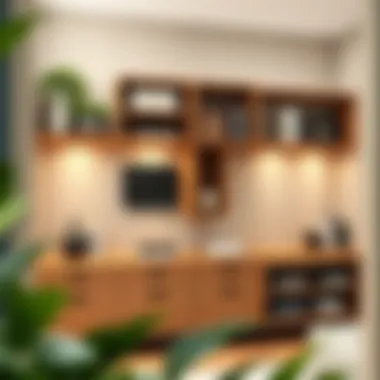
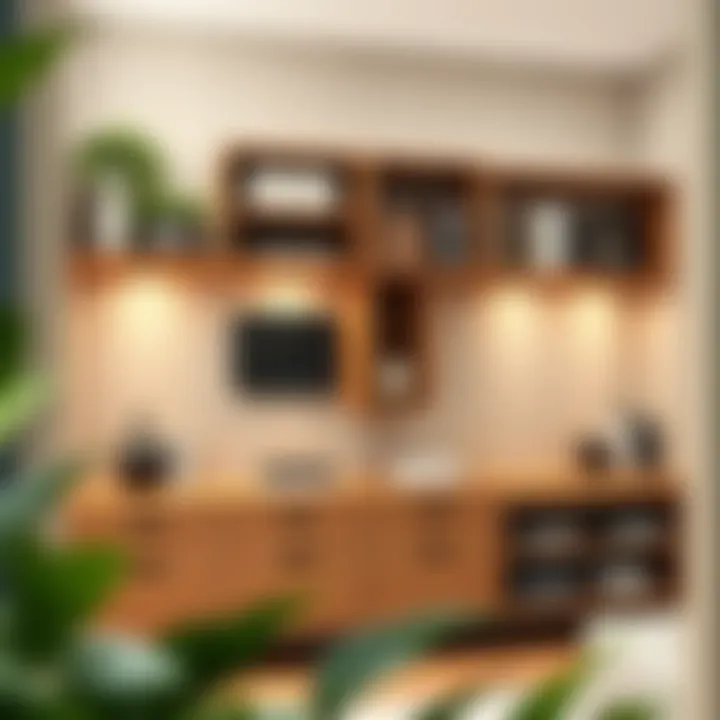
Efficient Organization
When it comes to keeping a home neat and tidy, organization is key. Closet drawers make it astonishingly easy to categorize and arrange items, thus reducing clutter. With different sizes and configurations, drawers can house everything from small accessories to bulky seasonal garments. For instance, a small drawer could serve as a perfect nook for underwear and socks, while deeper drawers can hold jeans and sweaters without them being crammed together.
Employing dividers or trays inside drawers can further enhance organization. These divisions allow for a structure that keeps things in their place, making locating a specific item as simple as pie. No more digging through piles, which not only wastes time but can also lead to frustration. Instead, each item is easily accessible, making life just a tad easier.
Space Maximization
Space is often at a premium in modern homes, and closet drawers excel at maximizing what little of it one might have. They utilize vertical space efficiently, allowing for thoughtful arrangements that make the most out of even the smallest areas. Utilizing drawers means that items can be stacked in a way that limits the horizontal spread, which is often where chaos breeds.
In a practical sense, think about an average closet with a combination of shelves and drawers. By placing drawers at the bottom, it’s possible to free up higher shelving for less frequently used items. This makes the entire setup more functional, as it encourages one to make efficient use of each section without letting clutter fester.
Privacy and Concealment
Closet drawers offer a level of privacy that open shelving simply cannot provide. When items are put away behind closed drawers, it can keep everything from attire to personal belongings out of sight. This is particularly useful in shared spaces or in bedrooms where one may wish to keep personal items private. The act of concealing items not only enhances privacy but also adds to a home's overall aesthetic by minimizing visual clutter.
Moreover, having a drawer system allows for easy management of sensitive items. Documents, valuables, and belongings that one might prefer not to display can be tucked away without a second thought. This gives individuals peace of mind, knowing that their belongings are safely stowed and less likely to attract unnecessary attention.
"In design, it's often what you don't see that holds the most value. Closet drawers are truley a design element that prioritizes practicality without sacrificing aesthetic appeal."
Overall, the functional benefits of closet drawers cannot be overlooked. They not only organize space but also optimize it in a way that aids daily life, all while maintaining a level of discretion that can be especially important in certain settings. By understanding and applying these benefits, homeowners and designers alike can transform a chaotic storage system into an efficiently organized environment.
Advantages of Shelf Units
Shelf units pack a punch when it comes to storage solutions. They’re not just planks of wood or metal; they’re a versatile element in home design that balances both function and style. In today’s world, where space comes at a premium and organization is key, understanding the advantages of shelf units can transform how you approach your living space.
Versatility in Design
One of the major benefits of shelf units is their versatility in design. They come in countless shapes, sizes, and materials, allowing homeowners and designers to tailor them according to specific needs and aesthetics. Whether you're going for a rustic vibe with reclaimed wood or a sleek modern look with glass and metal, the options are practically endless.
- Customizable: Many shelf units can be custom-built or easily modified to fit the unique dimensions of a room. This customization means they're not just an afterthought; they fit seamlessly into your space.
- Configuration options: From ladder-style shelves to traditional bookcases, configurations can often be adapted to suit different functions—a display for decor in the living room, practical storage in the kitchen, or even a workspace in a bedroom.
"Shelf units aren’t merely functional; they’re a statement piece that reflects personal style and enhances any interior design."
Easy Accessibility
When it comes to accessibility, shelf units excel. Unlike traditional enclosed storage options that can easily hide away items, shelves invite a level of transparency that promotes easy access and visibility. This feature is crucial for optimizing space.
- Open shelving: Open designs allow you to see all your items at a glance. You can grab your favorite book or the precise mixing bowl without digging through drawers.
- Organizational tactics: Implementing baskets or bins on shelves can further simplify access while still maintaining a clean look. Everything has its place but remains easy to reach.
In busy households, this straightforward accessibility is a game changer, especially in kitchens and children's rooms, where efficiency is key to maintaining order.
Aesthetic Appeal
Finally, let’s talk about the aesthetic appeal shelf units contribute to any home. They can be a focal point in a room or blend unobtrusively with the decor, enhancing the overall aesthetic without overwhelming it.
- Decorative potential: Shelves are not just for storage. They provide an excellent platform for displaying personal items—like plants, photos, or art pieces—giving a space character and a personal touch.
- Visual balance: Strategically placing shelves can draw the eye upwards, making a room feel taller and more spacious. This visual trick can be particularly beneficial in smaller homes.
Material Considerations
The choice of materials in closet drawers and shelf units is a cornerstone of effective storage solutions in home design. Various elements—durability, aesthetic compatibility, maintenance, and budget—interplay to determine which material fits best into your space. It’s not just a matter of picking something that looks nice; the material impacts functionality, how long your furniture lasts, and even how it blends with the rest of your decor.
Wood: Timeless and Durable
Wood has a long-standing reputation as a top choice for storage solutions, owing to its timeless nature and robust characteristics. The warmth and richness of wood evoke a comforting atmosphere, which is essential in residential spaces. Hardwoods like oak and cherry are particularly popular for their durability. They can withstand the wear and tear of daily use, making them a worthy investment.
- Aesthetic Appeal: Wood offers a variety of finishes that can match any interior design, from rustic to modern. You can find pieces that range from unfinished to sleek, polished options that shine.
- Customization: Wood can be easily altered or refurbished; if it develops scratches or wear, a simple sanding and a fresh coat of varnish can revive its look. Many people enjoy personalized touches, like carving names or designs, which add character.
On the flip side, wood does have its drawbacks. It can be sensitive to humidity and temperature changes, causing expansion or warping over time. Thus, proper care is essential to maintain appearance and functionality. Remember, moisture is wood's worst enemy, so keep it in mind when placing wooden units in humid locations.
Metal: Modern and Minimalist
Metal shelving and drawer units have surged in popularity, especially in industrial and contemporary designs. They deliver a sleek, modern vibe that works well with open-concept living. Metals like steel and aluminum boast incredible strength while being relatively lightweight.
- Durability: Metal is resistant to damage, making it a fantastic option for high-traffic areas or homes with young children and pets. It can handle significant weight, without bowing or collapsing under pressure.
- Ease of Maintenance: Metal surfaces are easy to wipe clean, and they often resist the buildup of dust and grime. In spaces like kitchens or bathrooms, this can be a significant advantage, as hygiene is paramount.
That said, metal can sometimes feel a bit cold or impersonal. To counter this, one can pair metal units with softer items, like decorative boxes or fabrics, to give a warmer and more inviting appeal.
Composite Materials: Budget-Friendly Options
When it comes to maximizing storage on a budget, composite materials prove invaluable. Made from bonded wood fibers or layered materials, composites like MDF (Medium Density Fiberboard) and particleboard offer an economical alternative to solid wood.
- Cost-Effectiveness: Composites are often significantly cheaper than solid woods but can still be covered with appealing veneers or laminates to give the appearance of high-end materials.
- Versatility: These materials can be molded into various shapes and styles, making them highly customizable. Designers can craft intricate details or simple slab designs, suitable for different preferences and spaces.
However, these materials are not without their cons. They typically lack the same structural integrity as solid wood or metal, making them less suitable for heavy-duty use. They are also more susceptible to moisture, so they require careful placement away from damp areas.


Remember: When selecting materials for your closet drawers and shelf units, consider not just aesthetics but also how they align with your lifestyle and specific storage needs.
Ultimately, whether you lean towards the classic elegance of wood, the sleek contemporary look of metal, or the affordability of composite materials, each choice brings its unique benefits to home design. It’s all about finding the perfect fit for your style, space, and budget.
Design Elements to Consider
When it comes to closet drawers and shelf units, the design elements selected play a crucial role in not just functionality, but also how the entire space feels and flows. Particularly for those who engage in interior design, the interplay of style, size, and customization options can significantly impact the overall effectiveness of these storage solutions. Here, we will delve into these elements, highlighting their benefits and considerations in creating optimal storage solutions.
Styles and Aesthetic Integration
Choosing the right style for closet drawers and shelf units is akin to selecting the perfect icing on a cake, enhancing the whole experience. Traditional, contemporary, rustic, or even industrial styles can be used effectively. The key lies in ensuring that the storage pieces blend harmoniously with the existing decor. For instance, a minimalist design in crisp white tends to suit modern aesthetics, while rich mahogany wood can add warmth to traditional spaces. Some may prefer combining styles to create a unique vibe, which can lead to an interesting and personalized outcome.
Integration of aesthetic elements also extends to finishes and colors. A unified color scheme can tie together disparate elements of a room, creating a seamless look that feels thoughtfully curated. Materials with textures—like reclaimed wood or matte metals—can also provide a visual interest that simpler designs might lack. By thoughtfully selecting styles that integrate well with the overall aesthetics, homeowners and designers alike can create spaces that not only function well but spark joy every time they’re used.
Size and Proportions
The dimensions and proportions of closet drawers and shelf units can make or break the functionality of a space. They should be tailored to fit the specific dimensions of the closet or wall where they will reside. Oversized units can make a space feel cramped, while too-small units might leave valuable real estate unused. Consider this: a long, shallow shelf might be perfect for displaying decorative items, whereas deep drawer units are ideal for storing bulkier clothing or linens.
When working on design, it’s essential to consider both height and width. Ceiling-height units utilize vertical space efficiently, without wasting any opportunity for storage. Conversely, low-profile units can provide ease of access, particularly for frequently used items. Using proportional elements ensures that all items fit snugly, while still allowing for visual clarity. The rhythm of space is maintained when everything feels right-sized—not too big, not too small, just perfectly arranged.
Customization Options
Customization is at the heart of modern storage solutions. Closet drawers and shelf units should not only serve their primary purpose but also reflect the unique preferences and needs of the user. Understanding customization is crucial for designers and homeowners who aim to maximize their space effectively. Adding features like pull-out shelves, convertible elements, or bespoke drawer sizes can dramatically enhance usability and aesthetics.
Custom finishes also allow individuals to express their style, whether it’s through specific finishes, colors, or even hardware choices. Utilizing modular systems permits adjustments as needs change over time; for example, using adjustable shelving can accommodate changing storage needs as seasons shift or family requirements change.
"Customization empowers creativity and enables a storage solution that is uniquely suited to each space"
With the ever-increasing trends leaning towards individual choices, inviting customization into the design process can lead to more satisfying and lasting storage solutions, elevating both functionality and personal expression.
In summary, paying close attention to styles, size, proportions, and customization can dramatically enhance the functionality and appeal of closet drawers and shelf units. By carefully considering these design elements, designers and homeowners can create harmonious spaces that are not only practical but also reflective of their personal style.
Organization Strategies for Closet Drawers
In today’s fast-paced world, maintaining an orderly home can seem like an uphill battle. One way to tackle this challenge is by implementing effective organization strategies for closet drawers. The way we manage our belongings directly impacts our ease of access and the overall aesthetic of our space. Proper organization not only maximizes the utility of closet drawers but also contributes to a serene living environment.
Categorizing Items
Categorizing items is a fundamental strategy in organizing closet drawers. The first step involves recognizing what you have; this means taking stock of all your belongings. For instance, if you open a drawer filled with assorted accessories, it can be overwhelming. However, by categorizing them into groups—such as jewelry, scarves, and belts—you create logical sections that not only make finding what you need easier but also enhance the visual appeal when you open the drawer.
"A place for everything, and everything in its place,” is often said. This rings true in organization, especially within the confines of drawers where visibility can be limited.
Furthermore, consider individual needs when categorizing. For example, if you’re a crafter, designating a drawer exclusively for supplies—and sub-categorizing them by type—can transform a chaotic mess into a streamlined storage solution.
Utilization of Dividers
Another vital strategy for optimizing closet drawers is the utilization of dividers. Simple yet effective, dividers help in keeping categorized items separate and organized. For those who use their drawers for clothing, like socks or undergarments, dividers can prevent the dreaded jumble that occurs over time. A simple bamboo or plastic divider can create sections in a drawer, allowing for a tidy appearance and easier access.
When it comes to creative storage options, consider adjustable dividers. These can be tailored to fit the dimensions of your drawer and can adapt to changing needs over time. This flexibility allows you to expand sections as collections grow or change. Placement of dividers should be intuitive; for instance, place your most commonly used items towards the front for swift retrieval.
Seasonal Adjustments
Lastly, seasonal adjustments play an instrumental role in maintaining organization within closet drawers. Items that are used less frequently—such as winter clothing or holiday decorations—should not reside in prime storage spots throughout the year. Instead, consider rotating these items based on the seasons.
For example, as the first sign of autumn appears, transition your summer attire out and replace it with heavier sweaters or thermal wear. This not only frees up valuable drawer space for more relevant items but also ensures you’re not rummaging around looking for a winter scarf in a month of sweltering heat. Making adjustments seasonally encourages a system that remains functional year-round, keeping your closet both organized and relevant.
In summary, by employing strategies such as categorizing items, utilizing dividers effectively, and making seasonal adjustments, you can significantly enhance the functionality of your closet drawers. These methods provide structure and ease, transforming everyday chores into a seamless experience while keeping your home’s aesthetic well-maintained.
Optimizing Shelf Units for Functionality
Shelf units are often underappreciated gems in the realm of storage solutions. They don't just hold items; they also contribute significantly to the overall functionality and aesthetics of a space. By optimizing these shelf units, one can vastly enhance both organization and usability in various areas of the home or office. This section delves into critical aspects like weight distribution, visibility, and creative displays that elevate shelf units from mere storage solutions to integral parts of home design.
Weight Distribution and Stability
When stacking items on shelves, understanding weight distribution is crucial. Uneven weight can lead to instability, which might cause shelves to sag or, in the worst-case scenario, come crashing down. For instance, heavier items like books should be stored closer to the bottom of the shelf to prevent tipping. In contrast, lighter objects can easily occupy higher levels without concern.
It's also worth considering the depth and the build materials of the shelf unit. Heavier wood shelves, for example, generally handle more weight compared to flimsy particle board. The nature of the installation—whether anchored to a wall or free-standing—will also affect how much weight can be safely stored without jeopardizing stability.
This meticulous attention to weight management ensures that your shelves remain reliable for daily use. Moreover, it minimizes damage, allowing your investment to last longer in good condition.
Layering for Visibility
Layering items on shelves can enhance visibility while maintaining an organized appearance. Instead of a jumbled heap, think of each shelf as a display area. For example, on a bookshelf, placing smaller items in front of larger ones creates depth but still allows easy access to everything. This method can also be used in kitchen shelving, where jars, mugs, and spices are arranged by height.
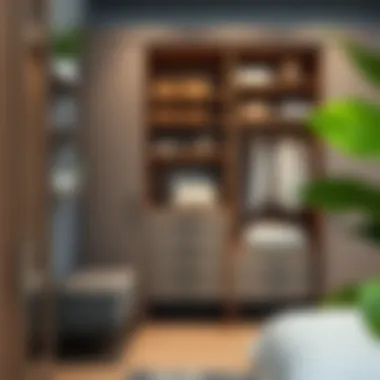
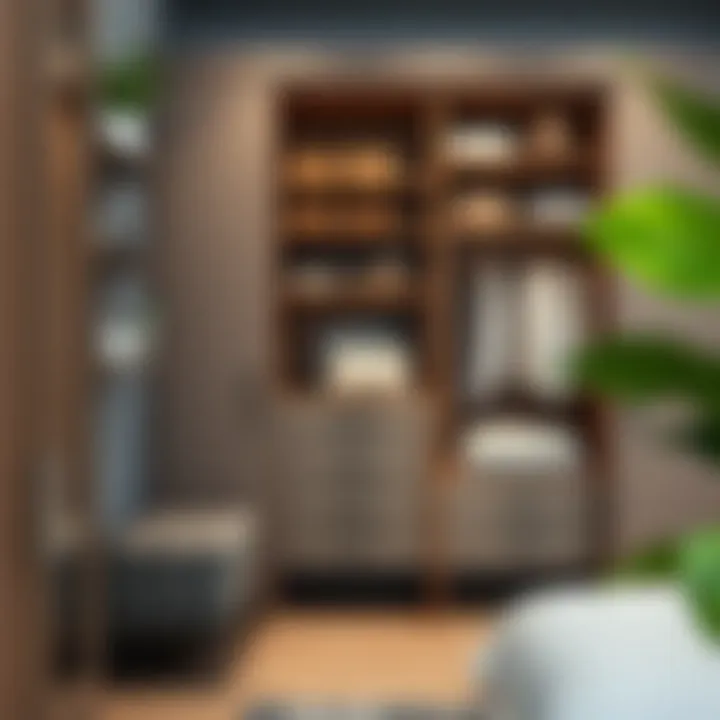
Utilizing clear bins or trays can assist in further organizing smaller items within larger displays, making them easier to find without having to sift through layers. The idea is to create an inviting space that beckons consumption, whether it’s showing off your favorite novels or your well-stocked spice collection. The goal is to ensure each item has a place, contributing to a more enjoyable and functional environment.
Creative Displays
Think outside the box when it comes to how you display items on your shelves. A shelf unit doesn't have to be solely functional—it can be a canvas for creativity. Add personal touches, such as decorative boxes, art pieces, or even plants that can bring life to a room. You might consider incorporating seasonal displays; rotating items seasonally gives an ever-fresh feel to your space.
Mixing materials can also create striking contrasts. For instance, pairing metallic accents with wooden shelves can generate a modern chic look. If one has the room for it, mixing vertical and horizontal arrangements can extend visual interest.
"The best shelf units don't just store; they tell a story. Every item, meticulously placed, adds character to the space."
In summary, optimizing shelf units transcends simple storage solutions. It involves a thoughtful approach to weight management, visibility through layering, and creative expression in displays. All these elements work together to create a more functional and aesthetically pleasing space. Keeping these ideas in mind can turn a regular bookshelf or kitchen shelf into a sophisticated showcase that aligns with your personal taste.
Maintenance and Care
When it comes to closet drawers and shelf units, maintenance and care are crucial to ensuring their longevity and maximizing their functionality. The subtleties involved in keeping these storage solutions in tip-top shape can ultimately affect overall space organization and aesthetics in a home. It's not just about visual appeal; improper care can lead to costly repairs or replacements in the long run, making it vital to understand best practices for their upkeep.
Cleaning Techniques
Regular cleaning is a no-brainer when it comes to preserving closet drawers and shelf units. It's important to delve into some effective cleaning techniques that cater to various materials. Here are some key strategies:
- Dusting: Using a microfiber cloth to wipe away dust is a quick yet effective way to keep items looking new, especially for wooden surfaces where dust can settle easily.
- Deeper Cleaning Solutions: For wooden drawers, a gentle cleaner specifically meant for wood can make a world of difference. It's best to avoid harsh chemicals, as they can strip the natural finish.
- For Metal Units: A simple blend of warm soapy water works wonders. Make sure to dry them immediately to avoid rust.
- Storage Spaces: Don't forget the insides! Remove contents and clean the interiors periodically. This ensures odors and grime don’t build up over time.
Preventing Damage and Wear
Preventing damage is often simpler than trying to fix it later. By adopting mindful habits, you can elongate the life of your storage furniture.
- Weight Limit Awareness: Know your unit's weight capacity and avoid overstuffing drawers and shelves. Excess weight can lead to warping or sagging over time.
- Gentle Usage: Be mindful when pulling drawers or placing heavy items on shelves. Jerky movements can weaken hinges or cause joints to wear out.
- Temperature Control: Extreme temperatures can cause materials to expand or contract. Position your furniture away from heat sources and humidity to shield it from unnecessary stress.
"An ounce of prevention is worth a pound of cure."
Restoration Strategies
Despite take precautions, sometimes damage can occur, and having a plan for restoration is key. Here are some strategies to consider:
- Refinishing Wooden Drawers: Scratches can be treated with a wood scratch repair pen or by applying an appropriate finish over the affected area. Occasionally, sanding down the surface and applying a new stain can restore its former glory.
- Repainting Metal Units: If your metal shelves show wear, a fresh coat of paint might rejuvenate their appearance. Use spray paint formulated for metal to ensure proper adhesion and durability.
- Replace Hardware: Hinges and handles can wear out over time. Keeping spare hardware on hand allows for immediate replacement, which can greatly enhance functionality without needing a complete overhaul of the unit.
In sum, the maintenance and care of closet drawers and shelf units are fundamental to their utility. By implementing effective cleaning techniques, taking steps to prevent damage, and being prepared for possible restoration, homeowners and designers can ensure these integral components of storage remain both functional and aesthetically pleasing.
Future Trends in Closet and Shelf Design
As we look towards the future, closet and shelf design is evolving in ways that reflect changing lifestyles and values. The growing emphasis on sustainability, technological integration, and modular designs are not mere trends; they represent a shift towards smarter, more efficient living spaces. Understanding these elements is critical for designers, homeowners, and retailers as they navigate the modern landscape of home organization and aesthetics.
Sustainable Practices
Sustainability is at the forefront of many industries today, and furniture design is no exception. In the realm of closet drawers and shelf units, this translates into the use of eco-friendly materials such as bamboo, reclaimed wood, and low-VOC finishes. The benefits of opting for sustainable practices are manifold. Not only do these materials reduce the environmental footprint, but they also offer unique aesthetic qualities that can elevate a space.
- Ecological Benefits: Using sustainably sourced wood means preserving forests and reducing waste, contributing positively to our planet.
- Healthier Living: Low-VOC finishes minimize harmful emissions in homes, allowing for cleaner indoor air quality.
- Distinct Style: Reclaimed materials often hold history and character, providing a unique touch that modern materials may lack.
"Embracing sustainability does not just benefit the environment; it often leads to a more captivating and unique design aesthetic that resonates with today's conscientious consumers."
Smart Home Integration
With the advent of smart home technology, closet and shelf units are also integrating with home automation systems. Imagine being able to monitor your belongings or even control lighting inside your closet remotely. Increasingly, designers are considering how these technologies can enhance functionality.
- Automated Organization: Some systems now come equipped with sensors that notify users when items are running low or when it’s time for seasonal swaps, creating a seamless organization experience.
- Adaptive Lighting: Incorporating LED lighting that adjusts according to the time of day or occupancy enhances usability, particularly in walk-in closets or dark alcoves.
- Mobile Connectivity: Through apps, users can arrange their closet spaces from their smartphones, adding convenience to daily routines.
Modular Systems
One of the major trends is the advent of modular design systems that allow for greater customization and flexibility. These systems enable users to create storage solutions that adapt to their needs over time.
- Scalable Units: You can start with a basic framework and expand as your storage needs evolve, offering longevity and value.
- Interchangeable Components: Users can mix and match various drawers and shelf units, enabling customization without having to replace entire systems.
- Easier Installation: Many modular systems come with user-friendly instructions, allowing DIY enthusiasts to set up their organization systems with minimal fuss.
Culmination
When it comes to the world of interior design, the importance of closet drawers and shelf units cannot be overstated. These elements serve not just a functional purpose, but contribute significantly to the overall aesthetic and organization of any space. By understanding their impact, designers and homeowners can make choices that enhance both usability and style in their environments.
Summarizing the Impact of Closet Drawers and Shelf Units
Closet drawers and shelf units have a profound effect on how we interact with our spaces. They are the unsung heroes of organization, providing designated spots for a variety of items, which can lead to less clutter and enhanced productivity. When items are easily accessible and orderly, the day-to-day experience in a home or office becomes significantly smoother. Moreover, these storage solutions allow for the maximization of available space; think of a narrow area that could be transformed into an efficient storage command center.
From a design perspective, these units also present opportunities for creative expression. Homeowners can select from a broad array of styles, colors, and materials that reflect their personal tastes and harmonize with existing decor. For instance, wooden units can add warmth and a touch of nature, while sleek metal shelves may usher in a modern vibe. Ultimately, the precise incorporation of closet drawers and shelf units can elevate a room from functional to fantastic.
"The right storage solution turns chaos into order, influences lifestyles, and enhances the beauty of our living areas."
Encouraging Thoughtful Design Choices
When choosing closet drawers and shelf units, intentionality is key. It's essential to think about not only your storage needs but also how these units will fit into your larger design vision. Here are several factors to consider:
- Functionality: Choose items that align with your lifestyle. Do you have a lot of shoes? Opt for deeper drawers specifically designed for footwear.
- Adaptability: Look for shelf units that can adapt as your needs change. Modular systems might be ideal, allowing you to reconfigure how you store your items over time.
- Aesthetic Appeal: Select materials and designs that resonate with you. Soft woods can create a cozy feel, while glass and metal often exude sophistication.
- Sustainability: In today's world, opting for eco-friendly materials can be a thoughtful choice, reflecting a commitment to responsible design.
Ultimately, by making informed and intentional decisions now, you can cultivate an environment that is not just aesthetically pleasing but also functional. Whether you're a designer working on a client’s home or a DIY enthusiast revamping your space, the choices you make about closet drawers and shelf units will have lasting impacts on your environment, your comfort, and ultimately, your way of life.















